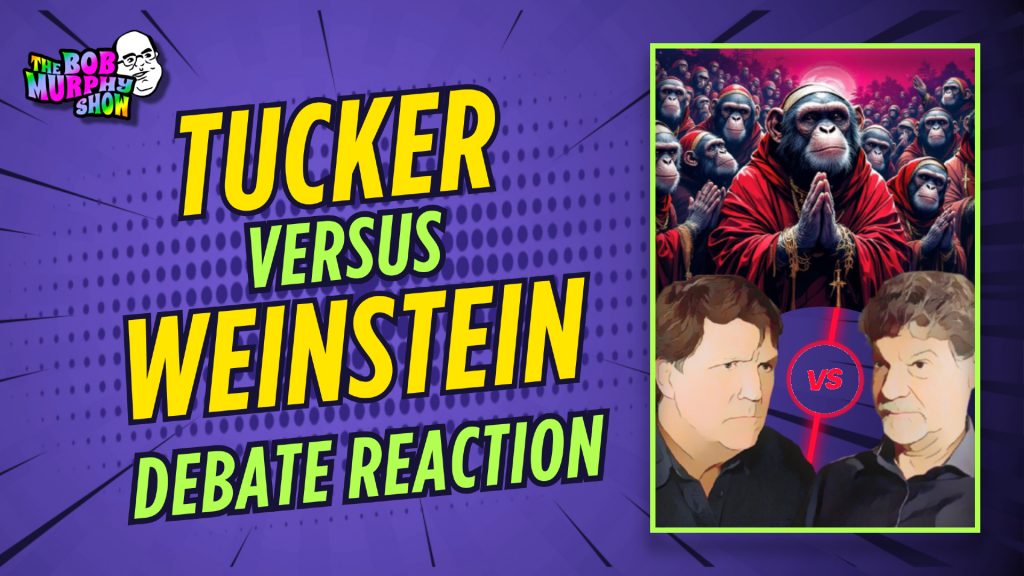Ep. 408 Responding to the Weinstein Tucker Debate on God and Evolution

As if they had watched the previous crossover, Bret Weinstein and Tucker Carlson discuss many of the same issues (such as the existence of God, the multiverse, the role of evolution) that Adam and Bob covered, but also a new one (human sacrifice). So the duo return for another crossover to react.
Mentioned in the Episode and Other Links of Interest:
- The YouTube version of this conversation.
- The Bret Weinstein appearance on Tucker Carlson.
- David Gornoski on the BMS talking about Rene Girard and scapegoats.
- The Martyr Made series on human sacrifice. The Pete Leeson paper.
- BMS ep 358 in which Adam and Bob discussed Nick Bostrum and simulation theory.
- The HamanNature substack.
- Help support the Bob Murphy Show.

Realizing that I couldn’t really describe baseball on any level I looked it up. Most description used something called an “objective” or a “purpose”.
So for those who think that baseball can be given a description in terns of molecules!
Could you be so kind to share the chemical formula for such entities?
Good point.
Interesting that people think cannibalism needs an evolutionary explanation as opposed to an aversion to cannibalism. Humans are made of meat and humans also like to eat meat.
I was going to make this point too, Dave, but the conversation moved on.
Huh. You’re absolutely right. My own aversion blinded me!
Good stuff!
Regarding human sacrifice, I came across a theory that explains its universality in terms of our evolutionary past. I’m surprised Bret didn’t mention it to Tucker.
It goes like this: Before they became hunters, our ancient ancestors were prey animals, preyed upon by lions, tigers, and bears! …snakes, raptors. etc. Like other prey animals, these proto-humans found safety in numbers.
But not everyone could escape the jaws of a hungry predator. It was usually a young or injured or sickly member of the group who would fall victim.
And just as in those nature shows where we see a pack of antelopes standing there watching one of its young members getting eaten alive by a large cat, so too our ancestors must have noticed that the danger passes once the predator has got its victim and is satiated (appeased) and the remaining members of the group are then free to resume their normal activities — until the next time the predator gets hungry.
Over time (perhaps tens of thousands of years), this pattern of predatory panic followed by “safety-in-appeasement” would have become well established and impressed itself upon the evolving mind of our primitive ancestors, working its way as a dominant theme into the earliest stories ever told and later informing the myths, rituals, and religions of our more recent ancestors.
Through inductive reasoning, our ancestors must have arrived at the conclusion that the death of one can safeguard the lives of many. At some point, it must have occurred to the elders that they could preemptively offer the predator what it wants as a way of containing the danger and ensuring the continued life of the group.
The idea of a blood sacrifice as a necessary offering to ensure group survival must be among the oldest ideas to captivate the human mind.
We can imagine the ecstasy felt by the survivors who, time after time, were delivered from evil by means of a sacrifice, feeling as though they were the “chosen” ones — chosen to go on living in perpetuity — as if some higher power was looking favorably upon them, “selecting” them for survival.
The survival value of this idea can be found in the practice it informs which allows humans to gain some measure of control over their predicament as prey animals, thus alleviating fear and enhancing group cooperation and the feeling of being special.
The proto-humans that “got it” and put the idea into practice must have enjoyed greater group cohesion or “at-one-ment,” which, in turn, encouraged greater cooperation in productive endeavors — including eventually *the hunt*, as our ancestors became hunters — thus allowing them to be more fruitful and to multiply under a greater division of labor (see God’s very first commandment to humans and other animals He created).
It’s not hard to imagine how the first elders or sages who realized the utility of blood sacrifice might have formed a separate class of specialists within the group: the high priests in charge of conducting the sacrifices — properly. In some cases, under certain demographic and environmental conditions, this group of specialists might have developed into a political class of rulers.
Of course, as technology advanced and humans became better hunters and growers of food, our more recent ancestors adapted the old ways and ideas to changing circumstances, refining the idea sacrifice in the way Jordan Peterson has outlined in his lectures on the Bible stories.
A lot of food for thought!
Check out Deadly Powers: Animal Predators and the Mythic Imagination by Paul Trout. https://archive.org/details/deadlypowersanim0000trou/page/n7/mode/2up?q=sacrifice.
Interesting, I had never heard of that mechanism.
I had not heard of that mechanism either until just recently. But I think it makes a lot of sense.
And it’s totally compatible with Darryl Cooper’s ideas and Gornoski’s scapegoating theory.
The urge to preemptively appease the predator may have been the initial impetus for blood sacrifice. Then over time the practice may have acquired cultural accretions and ritualistic upgrades that performed a variety of functions beyond dealing with predators, becoming an occasion for scapegoating, redistributive feasts, potlatch, gift-exchanges (barter), festival, etc.
Doesn’t really make sense to me. The predator is taking just one member of the group, regardless of whether they’re appeased or resisted. You’re not saving any more members of the group by sacrificing 1 than by letting nature take its course.
Maybe you could justify it by saying that they can choose the least valuable person to sacrifice (sounds like the predator was going to do that anyway by targeting the slowest / weakest), or that they can resolve the anxiety of every individual in the group by sacrificing 1, but that’s a significantly less compelling incentive.
Tyler: “Doesn’t really make sense to me. The predator is taking just one member of the group, regardless of whether they’re appeased or resisted. You’re not saving any more members of the group by sacrificing 1 than by letting nature take its course.”
Me: Yes, but until the predator takes its victim, every individual in the group is in danger of being eaten. No one can know for certain who the next victim will be. As dumb luck would have it, even the strongest individual could get eaten if he stumbles on a rock or is otherwise caught off guard.
(Note: the most highly valued members might not be the strongest and fastest, as you seem to assume. More on this below.)
So, the entire group is gripped by fear when predators approach. Panic ensues. Each individual realizes they could be the next victim. And who by chance wants to see their own child or mate ripped apart and eaten?
But, by preemptively offering the sacrificial victim — whatever the selection criteria might be (it probably varied over time and across different groups) — our ancestors could in this way gain some measure of control over their predicament and get some relief.
Tyler: “Maybe you could justify it by saying that they can choose the least valuable person to sacrifice (sounds like the predator was going to do that anyway by targeting the slowest / weakest), or that they can resolve the anxiety of every individual in the group by sacrificing 1, but that’s a significantly less compelling incentive.”
Me: I don’t think anyone shares your assumption that the slowest or weakest individuals are the least valuable.
Besides reducing uncertainty, blood sacrifice functions to protect highly valued members whose survival would bode well for the future reproductive success of the group (e.g., women and children).
This strikes me as a compelling incentive.
If the women and children are repeatedly picked off by predators more often than not, than that group’s viability over the long term looks pretty dim compared to other groups that take measures to protect their females and youth.
This group survival strategy continues to this day, as the strongest, most capable men are the ones who get sacrificed in war for the benefit of the larger group, particularly the women and children left behind. Men have always been cannon fodder. (That’s the kind of “patriarchy” we live in. Ha!)
Of course, whether or not these wars are actually fought in defense of society is a separate issue. Regardless of who the real beneficiaries of war happen to be, the propaganda is deemed compelling insofar as it makes the case that the group faces an existential threat.